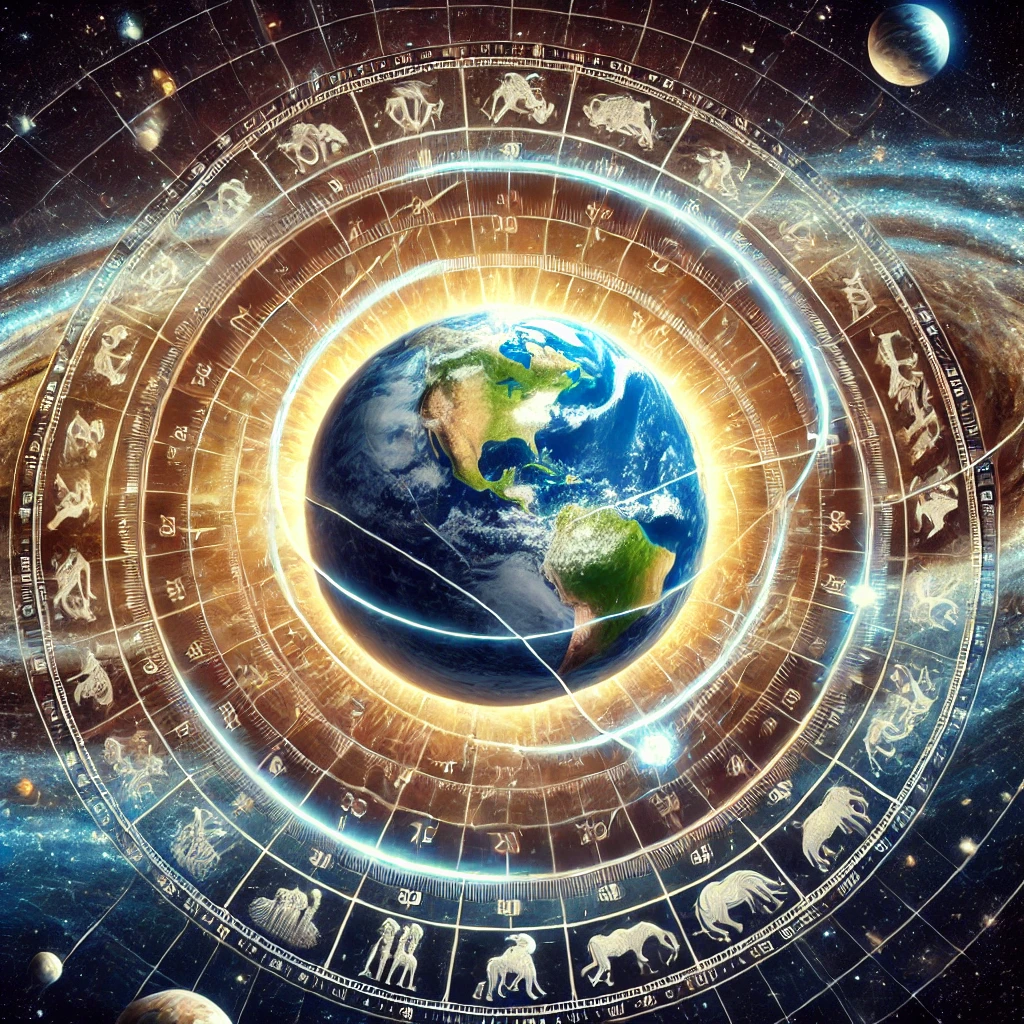Overview
The Precession of the Equinoxes is a slow, cyclical shift in Earth’s axial orientation that alters the position of the equinox points over time. This phenomenon, caused by gravitational interactions with the Sun and Moon, results in a gradual shift of the zodiacal constellations relative to Earth’s seasons.
This cycle, spanning approximately 25,772 years, is often referred to as the Great Year and has profound implications for astronomy, astrology, ancient civilizations, and spiritual traditions.
Scientific Explanation: What Causes Precession?
Earth’s Axial Wobble
- Earth is not a perfect sphere; its equatorial bulge is affected by the gravitational pull of the Moon, Sun, and planets.
- This causes a slow wobble in its rotational axis, similar to a spinning top slowing down.
- As a result, the position of the equinoxes (where the Sun crosses the celestial equator) shifts backward through the zodiac over thousands of years.
Key Features of Precession
- Precessional Cycle Length – Approximately 25,772 years, with variations due to gravitational influences.
- Shifting Zodiac Alignment – The March equinox point moves backward through the zodiac at a rate of one degree every 72 years.
- Observable Effects – Over millennia, the stars that align with the equinox change, affecting celestial navigation, astrology, and cultural star myths.
This gradual shift means that ancient civilizations, who aligned their calendars and monuments with the stars, experienced different equinox constellations than we do today.
Historical and Astronomical Importance
Discovery of Precession
- Hipparchus of Nicaea (2nd Century BCE) is credited with discovering precession by comparing older star charts with his own observations.
- Sir Isaac Newton (17th Century CE) explained precession through the principles of gravitational mechanics.
Impact on Astronomy
- Affects the alignment of celestial reference points used for navigation and space exploration.
- Causes a drift in the North Star—currently Polaris, but in ancient times, it was Thuban (Draco constellation) and will eventually be Vega (Lyra constellation).
- Alters the apparent position of stars over long periods, requiring calendar corrections and astronomical recalibrations.
The Precession Cycle and the Ages of the Zodiac
In astrology and esoteric traditions, the Precession of the Equinoxes is linked to the shifting of astrological ages, each lasting approximately 2,160 years.
The Great Year and Astrological Ages
The zodiacal age is determined by which constellation the Sun rises in on the March equinox.
- Age of Taurus (c. 4300 – 2150 BCE)
- Associated with bull-worshiping cultures (e.g., Egypt, Minoan Crete, Sumer).
- Symbolized earthly abundance, agriculture, and stability.
- Age of Aries (c. 2150 BCE – 1 CE)
- Marked the rise of warrior cultures, monotheism, and fire symbolism.
- Associated with the Ram (Ares/Mars energy) and conquest.
- Seen in the Old Testament, Roman expansion, and Persian traditions.
- Age of Pisces (c. 1 CE – Present Day)
- Symbolized by spirituality, sacrifice, and mysticism.
- Coincides with the rise of Christianity, represented by the fish.
- Themes of faith, compassion, and collective consciousness.
- Age of Aquarius (Emerging, c. 2000 – 4000 CE)
- Linked to technology, innovation, and humanitarian ideals.
- Represents collective enlightenment, freedom, and cosmic consciousness.
- Some believe this age marks a shift toward higher awareness and global unity.
Each transition is thought to bring cultural, social, and spiritual evolution, influencing historical cycles.
Cultural and Mythological Perspectives
Many ancient civilizations acknowledged precession and encoded it in their temples, calendars, and mythologies.
1. Egyptian Cosmology
- The Great Sphinx of Giza may have originally been aligned with Leo (c. 10,500 BCE), reflecting an earlier astrological age.
- The Temple of Karnak aligns with precessional shifts, adjusting to the movement of the stars.
2. Mayan Long Count Calendar
- The Mayan calendar cycles correspond with precessional ages, marking great cosmic shifts.
- The 2012 phenomenon was interpreted by some as the end of an old precessional age and the beginning of a new era.
3. Hindu Yuga Cycles
- Hindu cosmology describes a Great Cycle of Ages (Yugas) similar to precessional time scales.
- The transition between Yugas aligns with precession and shifts in consciousness.
4. Greek and Roman Traditions
- Plato referred to a “Great Year”, linking precession to cycles of civilization and planetary influence.
- The Roman Mithraic cult aligned rituals with precessional shifts.
Ancient cultures saw precession as a marker of cosmic change, guiding human evolution and spiritual awakening.
Metaphysical and Esoteric Interpretations
1. Precession as a Spiritual Evolutionary Cycle
- Some esoteric traditions view precession as a grand cycle of human awakening.
- Each zodiacal age brings shifts in consciousness, energy, and societal development.
- The transition from Pisces to Aquarius is often seen as a shift from religious dogma to higher awareness and unity consciousness.
2. Precession and DNA Activation
- Some theories suggest precession influences vibrational frequency changes in the human collective.
- Alignments with galactic centers during precessional cycles are believed to activate dormant knowledge and abilities.
3. The Galactic Connection
- Certain spiritual traditions link precession to Earth’s alignment with the Galactic Center in Sagittarius.
- These alignments are thought to bring waves of cosmic energy, influencing planetary ascension and human evolution.
While not scientifically verifiable, these perspectives highlight the deep symbolic significance of precession in human history and spirituality.
Practical Effects of Precession
Although precession is a slow cycle, it affects various aspects of science and culture.
1. Astronomical Adjustments
- Star charts and planetary calendars must be updated to account for precession.
- The zodiacal constellations shift gradually, meaning that some traditional astrological signs no longer align with their original placements.
2. Navigation and Celestial Mapping
- Ancient navigators relied on fixed star positions, which change due to precession.
- Modern astronomical calculations correct for precessional drift to ensure accuracy.
3. Climate and Earth Cycles
- Precession contributes to Milankovitch Cycles, influencing long-term climate changes.
- It affects glaciation cycles and the orientation of Earth’s seasons over thousands of years.
Conclusion
The Precession of the Equinoxes is a fundamental cosmic cycle shaping astronomy, history, mythology, and spiritual traditions.
- Astronomically, it explains the gradual shift of Earth’s equinoxes and zodiac alignment.
- Astrologically, it marks the transition of world ages, influencing human consciousness and societal change.
- Metaphysically, it is linked to spiritual evolution, energetic shifts, and the awakening of planetary consciousness.
As we continue transitioning from the Age of Pisces to the Age of Aquarius, precession serves as a reminder of Earth’s connection to cosmic rhythms and the larger cycles of time and transformation.

